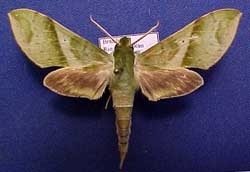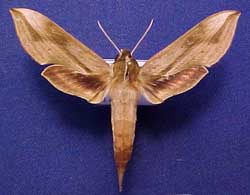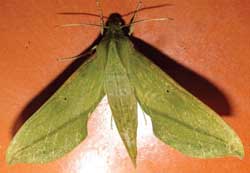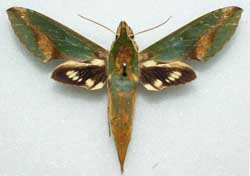
Xylophanes ceratomioides
Fw o.m. slightly scalloped.
Abdomen: three narrow, longitudinal lines; outer lines posteriorly divergent and expanded into triangular spots.
Costa: conspicuous subapical, apical black spots, largest subapical spot
triangular with inner point directed basally.
Median area running out to apex: pale brown with scattered black scales on veins; discal spot small,
black.
First four pm lines dissipate preapically before reaching costa, weak fifth line
runs to apex. First line slightly sinuate.
Second-fourth lines very scalloped near inner margin.
Oblique postmedian band dark with sinuate black lines within it, inner edge slightly undulate,
outer edge deeply excavate from CuA2 to just above M3,
forming a pale brown, oval patch; marginal area with black vein spots.
|

Xylophanes th. thyelia
Xylophanes thyelia has visible characters making it similar to members of the Xylophanes ceratomioides group, but it is a much smaller species.
The head has a dark longitudinal line, bordered ventrally with buff, above the antenna. The tegula have a dark brown median line, bordered on each side by a
pale grey stripe, irrorated with pale purple.
The abdomen has a brown midline, bordered by narrow grey lines; a brown lateral line present on segments 2-4, bordered ventrally by a pale buff line that
continues posteriorly to segment 7.
The forewing upperside is dark brown and buff. There is a short dark line present basal to the first postmedian line, reaching as far as the discal spot.
First, second and third postmedian lines arise almost from the wing base and are quite oblique. The first postmedian line reaches to just beyond M1;
the second postmedian line reaches Rs4; the third and fourth postmedian lines very narrow and close, sometimes fused for part of their length distally,
running from Rs4 to M3, below which they become a diffuse series of minute spots (continuous and distinct below M3 in Xylophanes thyelia salvini).
The area between the second and third postmedian lines, where they overlap, is conspicuously pale. The fifth postmedian line runs from the apex to M3 as a
gradually broadening triangular patch. There is an apical area bounded by the costa, fifth postmedian line and Rs4, and the tornal area bounded by M3, the
second postmedian line and CuA2, both pale brown and buff, with scattered individual black scales; Rs4, basal to second postmedian line, highlighted with
buff over distal half.
The forewing underside has three dark brown or black, parallel and equidistant postmedian lines.
The hindwing upperside is an almost uniform grey-brown. The median band is barely visible. in the male, the hindtibia have long scales dorsally and ventrally,
thus appearing very broad and compressed.
|
|
Very distinct species, unlikely to be confused with other species.

Xylophanes pistacina
Fw apex slightly produced, pointed.
O. m. hollowed out below apex,
evenly convex to anal angle.
G.c. variable: greenish-buff.
Three subparallel am lines, angled at
CUA1.
First two pm lines form broadly
preapical, prominent, straight, slightly oblique, dark band.
Third pml very faint.
Fourth pml distinct, vein dots.
Fifth pml curved from apex,
continuous with greenish olive patch from M2 to M3.

Xylophanes porcus EB
| |

Xylophanes marginalis EB

Xylophanes pluto
Tegulae: dark brown edges.
Fw apex slightly produced, pointed.
O. m. hollowed out below apex,
evenly convex, smooth or slightly crenulate, to anal angle.
Five subparallel am lines, evenly convex.
First pml thin but distinct,
slightly oblique, recurved toward body at costa.
Additional pmls very dentate, less distinct.
Prominent white subapical, basal-median suffusions.
|
|

Xylophanes t. tersa
Tegulae: strong orange midline.
Abdomen: four strong pale brown lines
over orange g. c., weaker midline, outer lines.
strong orange lateral bands
Fw o.m. slightly convex below hollowed out
subapical area.
1rst, 2nd pmls fused basally.
3rd, 4rth pmls thin over light background.
5-8th pml thicker, but weak basally.
Hw pale yellow spots generally elongating toward apex,
more basal closer to margin.
Thin orange suffusion above cream fringe.
Buenos Aires, Catamarca, Cordoba,
Corrientes, Entre Rios, Formosa, Jujuy, Misiones, Salta, San Luis,
Sante Fe, Tucuman
|

Xylophanes resta
forewing length: 36-41 mm.
Tegulae: weak golden midline.
Thorax: grey medial band, bordered laterally, divided medially by brown lines,
continuing along abdomen, becoming faint after first two abdominal segments.
Fw: characteristic brown tone,
First pml very strong basally, disappearing towards apex;
second pml fused basally with first;
fourth pml less than half width of first.
Hw pale yellow spots larger than tersa,
more distal closer to margin.
| |
|
Use your browser "Back" button to return to the previous page.
This page is brought to you by
Bill Oehlke and the
WLSS. Pages are on space rented from Bizland. If you would like
to become a "Patron of the Sphingidae Site", contact Bill.
Please send sightings/images to Bill. I will do my best to respond to
requests for identification help.
Visit Argentina Thumbnail Checklists:
Sphingini: Manduca
Sphingini: Agrius, Amphimoea, Cocytius, Euryglottis, Lintneria, Sphinx
Smerinthini: Adhemarius, Orecta and Protambulyx
Dilophonotini: Aleuron, Enyo, Pachygonidia and Unzela
Dilophonotini: Aellopos, Eupyrrhoglossum, Nyceryx and Perigonia
Dilophonotini: Callionima, Erinnyis, Hemeroplanes, Isognathus, Madoryx, Oryba, Pachylia, Pachylioides, Phryxus
and Pseudosphinx
Philampelini: Eumorpha
Macroglossini: Hyles and Xylophanes
 | 
Show appreciation for this site by clicking on flashing butterfly to the left.
The link will take you to a page with links to many insect sites. |
|
























